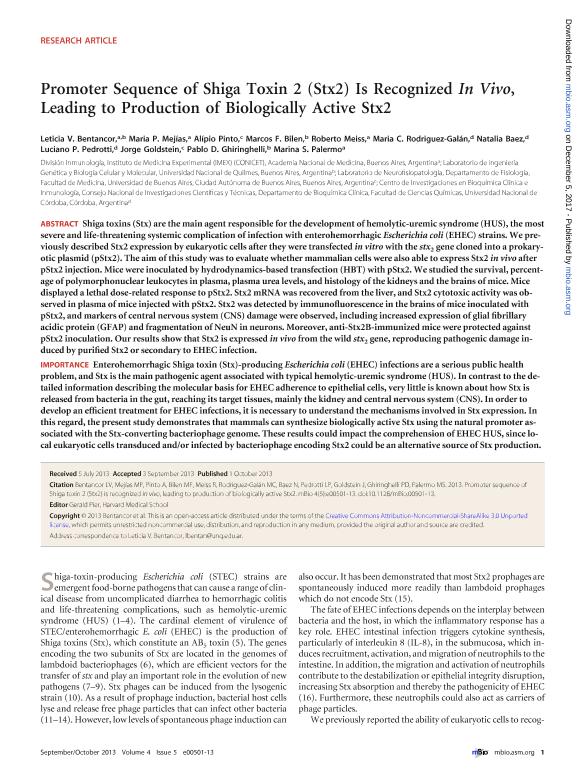Mostrar el registro sencillo del ítem
dc.contributor.author
Bentancor, Leticia Veronica

dc.contributor.author
Mejias, Maria Pilar

dc.contributor.author
Pinto, Alípio
dc.contributor.author
Bilen, Marcos Fabian

dc.contributor.author
Meiss, Roberto
dc.contributor.author
Rodriguez Galan, Maria Cecilia

dc.contributor.author
Baez, Natalia Soledad
dc.contributor.author
Pedrotti, Luciano Pablo

dc.contributor.author
Goldstein Raij, Jorge

dc.contributor.author
Ghiringhelli, Pablo Daniel

dc.contributor.author
Palermo, Marina Sandra

dc.date.available
2015-09-03T15:55:48Z
dc.date.issued
2013-10-01
dc.identifier.citation
Bentancor, Leticia Veronica; Mejias, Maria Pilar; Pinto, Alípio; Bilen, Marcos Fabian; Meiss, Roberto; et al.; Promoter sequence of Shiga Toxin II (Stx2) is recognized in vivo leading to the production of biologically active Stx2; American Society for Microbiology; mBio; 4; 5; 1-10-2013; 1-13
dc.identifier.issn
2150-7511
dc.identifier.uri
http://hdl.handle.net/11336/1913
dc.description.abstract
Shiga toxins (Stxs) are the main agent responsible for the development of hemolytic uremic syndrome (HUS), the most severe and life-threatening systemic complication of infection with enterohemorrhagic Escherichia coli (EHEC) strains. We previously reported Stx2 expression by eukaryotic cells after they were transfected in vitro with the stx2 gene cloned into a prokaryotic plasmid (pStx2). The aim of this study was to evaluate whether mammalian cells were also able to express Stx2 in vivo after pStx2 injection. Mice were inoculated by hydrodynamic based transfection (HBT) with pStx2. We studied the survival, the percentage of polymorphonuclear leukocytes in plasma, plasma urea levels and histology of the kidney and the brain of mice. Mice displayed a lethal dose-response to pStx2. Stx2-mRNA was recovered from the liver and Stx2 cytotoxic activity was observed in plasma of mice injected with pStx2. Stx2 was detected by immunofluorescence in the brains of mice inoculated with pStx2, and markers of central nervous system (CNS) damage were observed, including increased expression of glial fibrillary acidic protein (GFAP) and fragmentation of NeuN in neurons. Moreover, anti-Stx2B immunized mice were protected against pStx2 inoculation. Our results show that Stx2 is expressed in vivo from the wild stx2 gene, reproducing pathogenic damage induced by purified Stx2 or secondary to EHEC-infection.
dc.format
application/pdf
dc.language.iso
eng
dc.publisher
American Society for Microbiology

dc.rights
info:eu-repo/semantics/openAccess
dc.rights.uri
https://creativecommons.org/licenses/by-nc-sa/2.5/ar/
dc.subject
Stxe
dc.subject
Promoter
dc.subject.classification
Biología Celular, Microbiología

dc.subject.classification
Ciencias Biológicas

dc.subject.classification
CIENCIAS NATURALES Y EXACTAS

dc.title
Promoter sequence of Shiga Toxin II (Stx2) is recognized in vivo leading to the production of biologically active Stx2
dc.type
info:eu-repo/semantics/article
dc.type
info:ar-repo/semantics/artículo
dc.type
info:eu-repo/semantics/publishedVersion
dc.date.updated
2016-03-30 10:35:44.97925-03
dc.journal.volume
4
dc.journal.number
5
dc.journal.pagination
1-13
dc.journal.pais
Estados Unidos

dc.journal.ciudad
Washington
dc.description.fil
Fil: Bentancor, Leticia Veronica. Universidad Nacional de Quilmes. Departamento de Ciencia y Tecnología. Laboratorio de Ingeniería Genética y Biología Molecular y Celular; Argentina. Consejo Nacional de Investigaciones Científicas y Técnicas. Instituto de Medicina Experimental; Argentina
dc.description.fil
Fil: Mejias, Maria Pilar. Consejo Nacional de Investigaciones Científicas y Técnicas. Instituto de Medicina Experimental; Argentina
dc.description.fil
Fil: Pinto, Alípio. Universidad de Buenos Aires. Facultad de Medicina. Departamento de Ciencias Fisiológicas; Argentina
dc.description.fil
Fil: Bilen, Marcos Fabian. Universidad Nacional de Quilmes. Departamento de Ciencia y Tecnología. Laboratorio de Ingeniería Genética y Biología Molecular y Celular; Argentina
dc.description.fil
Fil: Meiss, Roberto. Consejo Nacional de Investigaciones Científicas y Técnicas. Instituto de Medicina Experimental; Argentina
dc.description.fil
Fil: Rodriguez Galan, Maria Cecilia. Consejo Nacional de Investigaciones Científicas y Técnicas. Centro Científico Tecnológico - CONICET - Córdoba. Centro de Investigaciones en Bioquímica Clínica e Inmunología; Argentina
dc.description.fil
Fil: Baez, Natalia Soledad. Consejo Nacional de Investigaciones Científicas y Técnicas. Centro Científico Tecnológico - CONICET - Córdoba. Centro de Investigaciones en Bioquímica Clínica e Inmunología; Argentina
dc.description.fil
Fil: Pedrotti, Luciano Pablo. Consejo Nacional de Investigaciones Científicas y Técnicas. Centro Científico Tecnológico - CONICET - Córdoba. Centro de Investigaciones en Bioquímica Clínica e Inmunología; Argentina
dc.description.fil
Fil: Goldstein Raij, Jorge. Universidad de Buenos Aires. Facultad de Medicina. Departamento de Ciencias Fisiológicas. Laboratorio de Fisiopatogenia; Argentina
dc.description.fil
Fil: Ghiringhelli, Pablo Daniel. Universidad Nacional de Quilmes. Departamento de Ciencia y Tecnología. Laboratorio de Ingeniería Genética y Biología Molecular y Celular; Argentina
dc.description.fil
Fil: Palermo, Marina Sandra. Consejo Nacional de Investigaciones Científicas y Técnicas. Instituto de Medicina Experimental. Academia Nacional de Medicina de Buenos Aires. Instituto de Medicina Experimental; Argentina
dc.journal.title
mBio
dc.relation.isreferencedin
info:eu-repo/semantics/reference/url/info:eu-repo/semantics/reference es info:eu-repo/semantics/reference/pmid/24085779
dc.relation.alternativeid
info:eu-repo/semantics/altIdentifier/doi/http://dx.doi.org/10.1128/mBio.00501-13
dc.relation.alternativeid
info:eu-repo/semantics/altIdentifier/url/http://mbio.asm.org/content/4/5/e00501-13
Archivos asociados
